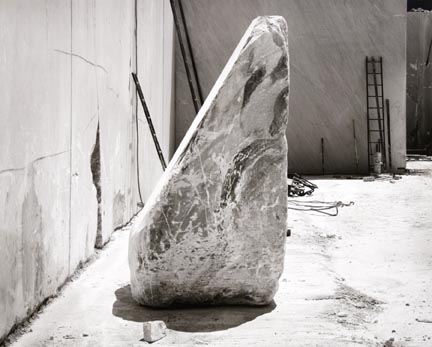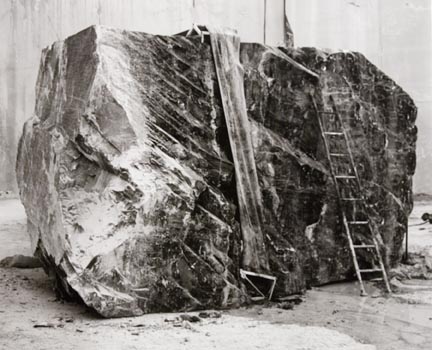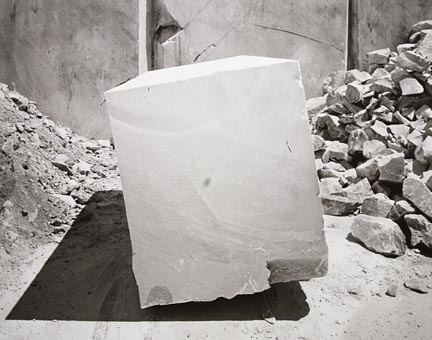About the Photographer
Wylie, William
American, b. 1957
For his series Carrara, William Wylie spent six years photographing and filming the massive marble slabs excavated at the Cava di Gioia quarry in Carrara, Italy. This renowned and still active mine has provided raw material for some of the world’s most celebrated sculptures, including The Pantheon, Michelangelo’s David, and London’s Marble Arch, and rock continues to be extracted as a building material for luxury homes and high end architecture. Drawing on this rich history and mystique, Wylie’s photographs consider the early stages of marble production when the crude shape and form of each slab is yet to be transformed into a commodity or work of art. The sculptural quality of the stones, even in their unfinished state, is highlighted in his black and white images through straightforward, centered compositions that emphasize the geometry and surface of each block, recalling 1960s minimalist sculptures by artists such as Donald Judd and Carl Andre. These formal choices reflect Wylie’s fascination with the transition rock undergoes as it is cut from the ground and becomes an object rather than earthen mineral.
The series also includes on-site color portraits of laborers, known as cavatori, who mine the marble at Cava di Gioia. Centrally composed in the same manner as Wylie’s photographs of the marble slabs, the cavatori stand covered in dust and grit with tools and the quarry as a backdrop. They pose in a manner very similar to Michelangelo’s David, shifting their weight to one leg while resting the other. The central compositions and choice of pose creates a dialogue between the black and white images of rough-hewn marble slabs and the color images of the statue-like cavatori, as if a sculptor has just finished carving them and they came to life, like Pygmalion. Another reading could situate the cavatori as sculptors cutting the marble, with the quarry as their studio. Here, Wylie blurs distinctions between artistic production and manufacture to supplement the interplay between sculpture and photography in Carrara.
William Wylie completed a BFA at Colorado State University, Ft. Collins (1986), and an MFA at the University of Michigan, Ann Arbor (1989). His work has exhibited extensively and is held in many collections, including the Center for Creative Photography, Tucson, AZ; Denver Art Museum, CO; Metropolitan Museum of Art, New York; Smithsonian American Art Museum, Washington, DC; and Yale University Art Gallery, New Haven, CT. Monographs include Riverwalk: Explorations Along the Cache Las Poudre River (2000), Stillwater (2002), Carrara (2009), and Route 36 (2010). Wylie received a John Simon Guggenheim Memorial Fellowship in 2005. He is Associate Professor of Art at the University of Virginia in Charlottesville, VA.
http://people.virginia.edu/~ww9b/




